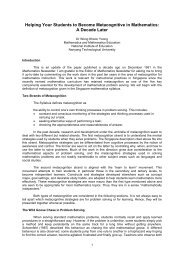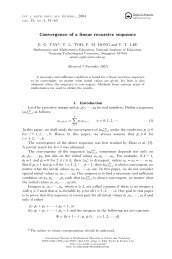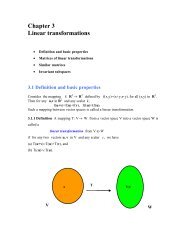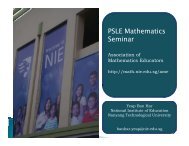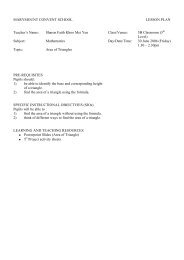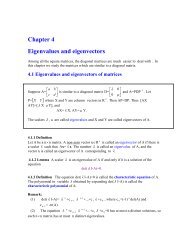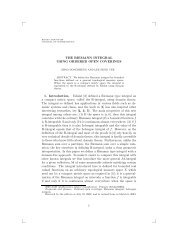Chromatic Polynomials and Chromaticity of Graphs - NIE ...
Chromatic Polynomials and Chromaticity of Graphs - NIE ...
Chromatic Polynomials and Chromaticity of Graphs - NIE ...
Create successful ePaper yourself
Turn your PDF publications into a flip-book with our unique Google optimized e-Paper software.
<strong>Chromatic</strong> <strong>Polynomials</strong> <strong>and</strong> <strong>Chromatic</strong>ity <strong>of</strong><br />
<strong>Graphs</strong><br />
F.M. Dong<br />
Mathematics <strong>and</strong> Mathematics Education, National Institute <strong>of</strong> Education<br />
Nanyang Technological University, Singapore<br />
K.M. Koh<br />
Department <strong>of</strong> Mathematics, National University <strong>of</strong> Singapore, Singapore<br />
K.L. Teo<br />
Institute <strong>of</strong> Fundamental Sciences, Massey University, New Zeal<strong>and</strong>
Preface<br />
For a century, one <strong>of</strong> the most famous problems in mathematics was to prove<br />
the four-colour theorem. This has spawned the development <strong>of</strong> many useful<br />
tools for solving graph colouring problems. In a paper in 1912, Birkh<strong>of</strong>f<br />
proposed a way <strong>of</strong> tackling the four-colour problem by introducing a function<br />
P (M, λ), defined for all positive integers λ, to be the number <strong>of</strong> proper<br />
λ-colourings <strong>of</strong> a map M. It turns out that P (M, λ) is a polynomial in λ,<br />
called the chromatic polynomial <strong>of</strong> M. If one could prove that P (M, 4) > 0<br />
for all maps M, then this would give a positive answer to the four-colour<br />
problem. The polynomial P (M, λ) is defined for all real <strong>and</strong> complex values<br />
<strong>of</strong> λ. It was hoped that many useful tools from algebra <strong>and</strong> analysis could<br />
be used to find or estimate the roots <strong>of</strong> the polynomial <strong>and</strong> hence lead to<br />
the resolution <strong>of</strong> the problem.<br />
The notion <strong>of</strong> a chromatic polynomial was later generalized to that <strong>of</strong><br />
an arbitrary graph by Whitney (1932), who established many fundamental<br />
results for it. In 1946, Birkh<strong>of</strong>f <strong>and</strong> Lewis obtained results concerning the<br />
distribution <strong>of</strong> real roots <strong>of</strong> chromatic polynomials <strong>of</strong> planar graphs <strong>and</strong><br />
conjectured that these polynomials have no real roots greater than or equal<br />
to four. The conjecture remains open.<br />
In 1968, Read aroused new interest in the study <strong>of</strong> chromatic polynomials<br />
with his well referenced introductory article on the subject. He asked if<br />
it is possible to find a set <strong>of</strong> necessary <strong>and</strong> sufficient algebraic conditions for<br />
a polynomial to be the chromatic polynomial <strong>of</strong> some graph. For example,<br />
it is true that the chromatic polynomial <strong>of</strong> a graph determines the numbers<br />
<strong>of</strong> vertices <strong>and</strong> edges <strong>and</strong> that its coefficients are integers which alternate<br />
in sign. Read observed that the absolute values <strong>of</strong> the coefficients appear<br />
to form a unimodal sequence.<br />
Read asked: What is a necessary <strong>and</strong> sufficient condition for two graphs<br />
to be chromatically equivalent; that is, to have the same chromatic polynomial?<br />
In particular, Chao <strong>and</strong> Whitehead Jr. (1978) defined a graph to<br />
V
VI<br />
Preface<br />
be chromatically unique if no other graphs share its chromatic polynomial.<br />
They found several families <strong>of</strong> such graphs. Since then many invariants<br />
under chromatic equivalence have been found <strong>and</strong> various families <strong>of</strong> <strong>and</strong><br />
results on such graphs have been obtained successively. The question <strong>of</strong><br />
chromatic equivalence <strong>and</strong> uniqueness is termed the chromaticity <strong>of</strong> graphs.<br />
This remains an active area <strong>of</strong> research.<br />
Although Birkh<strong>of</strong>f’s hope <strong>of</strong> using the chromatic polynomial to prove the<br />
four-colour theorem was not borne out, it has attracted a steady stream <strong>of</strong><br />
attention through the years, especially concerning the location <strong>of</strong> its roots.<br />
More recently, Thomassen discovered a relation between hamiltonian paths<br />
<strong>and</strong> the roots <strong>of</strong> the chromatic polynomial. There has also been an influx<br />
<strong>of</strong> new ideas from statistical mechanics due to the recent discovery <strong>of</strong> a<br />
connection to the Potts Model in Physics.<br />
This book is divided into three main parts, after providing a chapter on<br />
the basic concepts <strong>and</strong> terminology <strong>of</strong> graphs <strong>and</strong> a list <strong>of</strong> notation that are<br />
needed <strong>and</strong> used in the book. Part one covers the first three chapters. It is<br />
devoted in greater detail than the other two to the rudiment <strong>of</strong> chromatic<br />
polynomials; their basic properties are derived, <strong>and</strong> some practical methods<br />
for computing them are given. Furthermore, we provide several ways <strong>of</strong><br />
constructing chromatically equivalent graphs; characterize chromatically<br />
unique graphs that are disconnected <strong>and</strong> those with connectivity 1. Further<br />
results on chromatic equivalence classes <strong>of</strong> families <strong>of</strong> graphs are mentioned.<br />
Part two, which consists <strong>of</strong> eight chapters from Chapter 4 to Chapter 11,<br />
deals specifically with the chromaticity <strong>of</strong> multi-partite graphs, subdivisions<br />
<strong>of</strong> graphs, <strong>and</strong> members <strong>of</strong> those families whose colour classes have nice<br />
structures. By exp<strong>and</strong>ing a chromatic polynomial <strong>of</strong> a graph in terms <strong>of</strong><br />
falling factorials, we construct a polynomial, called the adjoint polynomial<br />
<strong>of</strong> the graph. We study several invariants <strong>of</strong> this polynomial <strong>and</strong> roots <strong>of</strong><br />
some particular ones. It was found that this polynomial was particularly<br />
useful in determining the chromaticity <strong>of</strong> graphs whose complements are <strong>of</strong><br />
simpler structure. We also mention some related polynomials.<br />
The last part <strong>of</strong> the book covers the last four chapters <strong>and</strong> is concerned<br />
with the distribution <strong>of</strong> roots <strong>of</strong> the chromatic polynomials both on the<br />
real line <strong>and</strong> in the complex plane. In particular, we study those chromatic<br />
polynomials that possess only integral roots. Furthermore, we study bounds<br />
<strong>and</strong> inequalities <strong>of</strong> the chromatic polynomials <strong>of</strong> families <strong>of</strong> graphs.<br />
Acknowledgement<br />
The authors would like to express their appreciation to several people
Preface<br />
VII<br />
<strong>and</strong> institutions for their assistance in writing this book. Special thanks<br />
to reviewers Gek-Ling Chia, Ru-Ying Liu, Yee-Hock Peng, Ronald Read,<br />
Chin-Ann Soh, Alan Sokal, Chung-Piaw Teo, Ioan Tomescu <strong>and</strong> Hai-Xing<br />
Zhao for making corrections <strong>and</strong> providing valuable suggestions for improvement.<br />
They thank Debbie Ormsby <strong>of</strong> Massey University, New Zeal<strong>and</strong>, for<br />
her help in preparing part <strong>of</strong> the manuscript <strong>and</strong> drafting the figures. KMK<br />
wishes to thank the Mathematics Departments <strong>of</strong> Simon Fraser University,<br />
Canada, <strong>and</strong> Shanghai Jiao Tong University, China for their hospitality<br />
during his sabbatical leave in 2002. KLT is grateful for the financial support<br />
rendered by National University <strong>of</strong> Singapore towards this project,<br />
<strong>and</strong> valuable assistance given by his colleague Charles Little.<br />
F.M. Dong, K.M. Koh <strong>and</strong> K.L. Teo<br />
Singapore<br />
December, 2004
Contents<br />
Preface<br />
Basic Concepts in Graph Theory<br />
Notation<br />
V<br />
XV<br />
XXV<br />
1 The Number <strong>of</strong> λ-colourings <strong>and</strong> Its Enumerations 1<br />
1.1 Introduction . . . . . . . . . . . . . . . . . . . . . . . . . . . 1<br />
1.2 Examples . . . . . . . . . . . . . . . . . . . . . . . . . . . . 2<br />
1.3 Basic results on enumeration <strong>of</strong> P (G, λ) . . . . . . . . . . . 4<br />
1.4 P (G, λ) in factorial form . . . . . . . . . . . . . . . . . . . . 9<br />
1.5 The join <strong>of</strong> graphs <strong>and</strong> the umbral product . . . . . . . . . 12<br />
1.6 P (G, λ) in tree form . . . . . . . . . . . . . . . . . . . . . . 14<br />
Exercise 1 . . . . . . . . . . . . . . . . . . . . . . . . . . . . . . . 17<br />
2 <strong>Chromatic</strong> <strong>Polynomials</strong> 23<br />
2.1 Introduction . . . . . . . . . . . . . . . . . . . . . . . . . . . 23<br />
2.2 An interpretation <strong>of</strong> the coefficients . . . . . . . . . . . . . . 24<br />
2.3 Broken-cycle Theorem . . . . . . . . . . . . . . . . . . . . . 26<br />
2.4 The multiplicity <strong>of</strong> root ‘1’ . . . . . . . . . . . . . . . . . . . 35<br />
2.5 Least coefficients . . . . . . . . . . . . . . . . . . . . . . . . 37<br />
2.6 Divisibility <strong>of</strong> the coefficients . . . . . . . . . . . . . . . . . 42<br />
2.7 Unimodal Conjecture . . . . . . . . . . . . . . . . . . . . . . 47<br />
Exercise 2 . . . . . . . . . . . . . . . . . . . . . . . . . . . . . . . 51<br />
3 <strong>Chromatic</strong> Equivalence <strong>of</strong> <strong>Graphs</strong> 55<br />
3.1 Introduction . . . . . . . . . . . . . . . . . . . . . . . . . . . 55<br />
3.2 <strong>Chromatic</strong>ally equivalent graphs . . . . . . . . . . . . . . . 56<br />
3.3 Equivalence classes <strong>and</strong> χ- unique graphs . . . . . . . . . . 63<br />
IX
X<br />
Contents<br />
3.4 Disconnected χ-unique graphs . . . . . . . . . . . . . . . . . 65<br />
3.5 One-connected χ-unique graphs . . . . . . . . . . . . . . . . 66<br />
3.6 χ-unique graphs with connectivity 2 . . . . . . . . . . . . . 68<br />
3.7 A chromatically equivalence class . . . . . . . . . . . . . . . 71<br />
3.8 Further results . . . . . . . . . . . . . . . . . . . . . . . . . 73<br />
3.8.1 A K 3 -gluing <strong>of</strong> graphs . . . . . . . . . . . . . . . . . 73<br />
3.8.2 Polygon-trees <strong>and</strong> related structures . . . . . . . . . 75<br />
3.8.3 2-connected (n, n + k)-graphs with small k . . . . . 76<br />
Exercise 3 . . . . . . . . . . . . . . . . . . . . . . . . . . . . . . . 80<br />
4 <strong>Chromatic</strong>ity <strong>of</strong> Multi-partite <strong>Graphs</strong> 83<br />
4.1 Introduction . . . . . . . . . . . . . . . . . . . . . . . . . . . 83<br />
4.2 Complete bipartite graphs . . . . . . . . . . . . . . . . . . . 84<br />
4.3 Complete tripartite graphs . . . . . . . . . . . . . . . . . . . 86<br />
4.4 Complete multi-partite graphs . . . . . . . . . . . . . . . . 90<br />
4.5 Complete bipartite graphs with some edges deleted . . . . . 94<br />
4.6 Further results . . . . . . . . . . . . . . . . . . . . . . . . . 99<br />
Exercise 4 . . . . . . . . . . . . . . . . . . . . . . . . . . . . . . . 101<br />
5 <strong>Chromatic</strong>ity <strong>of</strong> Subdivisions <strong>of</strong> <strong>Graphs</strong> 105<br />
5.1 Introduction . . . . . . . . . . . . . . . . . . . . . . . . . . . 105<br />
5.2 Multi-bridge graphs . . . . . . . . . . . . . . . . . . . . . . 106<br />
5.2.1 <strong>Chromatic</strong> polynomials <strong>of</strong> multi-bridge graphs . . . 106<br />
5.2.2 Generalized polygon-trees . . . . . . . . . . . . . . . 109<br />
5.2.3 <strong>Chromatic</strong>ity <strong>of</strong> k-bridge graphs with k = 4, 5, 6 . . . 111<br />
5.2.4 <strong>Chromatic</strong>ity <strong>of</strong> general multi-bridge graphs . . . . . 112<br />
5.3 <strong>Chromatic</strong>ity <strong>of</strong> generalized polygon-trees . . . . . . . . . . 114<br />
5.4 K 4 -homeomorphs . . . . . . . . . . . . . . . . . . . . . . . . 118<br />
5.5 <strong>Chromatic</strong>ity <strong>of</strong> uniform subdivisions <strong>of</strong> graphs . . . . . . . 123<br />
5.6 Further results . . . . . . . . . . . . . . . . . . . . . . . . . 127<br />
Exercise 5 . . . . . . . . . . . . . . . . . . . . . . . . . . . . . . . 130<br />
6 <strong>Graphs</strong> in Which any Two Colour Classes Induce a Tree<br />
(I) 133<br />
6.1 Introduction . . . . . . . . . . . . . . . . . . . . . . . . . . . 133<br />
6.2 The sizes <strong>and</strong> triangle numbers <strong>of</strong> graphs in T r . . . . . . . 135<br />
6.3 <strong>Graphs</strong> in T r . . . . . . . . . . . . . . . . . . . . . . . . . . 139<br />
6.4 Chordal graphs . . . . . . . . . . . . . . . . . . . . . . . . . 141<br />
6.5 q-trees . . . . . . . . . . . . . . . . . . . . . . . . . . . . . . 144
Contents<br />
XI<br />
Exercise 6 . . . . . . . . . . . . . . . . . . . . . . . . . . . . . . . 147<br />
7 <strong>Graphs</strong> in Which any Two Colour Classes Induce a Tree<br />
(II) 149<br />
7.1 Introduction . . . . . . . . . . . . . . . . . . . . . . . . . . . 149<br />
7.2 The number s 3 (H) . . . . . . . . . . . . . . . . . . . . . . . 151<br />
7.3 The family T 3,1 . . . . . . . . . . . . . . . . . . . . . . . . . 153<br />
7.4 The structure <strong>of</strong> graphs in T r,1 (r ≥ 4) . . . . . . . . . . . . 156<br />
7.5 <strong>Chromatic</strong>ally unique graphs in T r,1 . . . . . . . . . . . . . 161<br />
7.6 Further results . . . . . . . . . . . . . . . . . . . . . . . . . 164<br />
Exercise 7 . . . . . . . . . . . . . . . . . . . . . . . . . . . . . . . 167<br />
8 <strong>Graphs</strong> in Which All but One Pair <strong>of</strong> Colour Classes Induce<br />
Trees (I) 169<br />
8.1 Introduction . . . . . . . . . . . . . . . . . . . . . . . . . . . 169<br />
8.2 The triangle number <strong>and</strong> an upper bound . . . . . . . . . . 170<br />
8.3 <strong>Graphs</strong> in F r having maximum triangle numbers . . . . . . 172<br />
8.4 A more general result . . . . . . . . . . . . . . . . . . . . . 177<br />
Exercise 8 . . . . . . . . . . . . . . . . . . . . . . . . . . . . . . . 178<br />
9 <strong>Graphs</strong> in Which All but One Pair <strong>of</strong> Colour Classes Induce<br />
Trees (II) 179<br />
9.1 Introduction . . . . . . . . . . . . . . . . . . . . . . . . . . . 179<br />
9.2 Classification <strong>of</strong> graphs satisfying (CT) . . . . . . . . . . . 180<br />
9.3 <strong>Graphs</strong> in CT . . . . . . . . . . . . . . . . . . . . . . . . . . 184<br />
9.4 <strong>Graphs</strong> containing exactly one pure cycle . . . . . . . . . . 185<br />
9.5 The main results . . . . . . . . . . . . . . . . . . . . . . . . 188<br />
9.6 Further results . . . . . . . . . . . . . . . . . . . . . . . . . 190<br />
Exercise 9 . . . . . . . . . . . . . . . . . . . . . . . . . . . . . . . 193<br />
10 <strong>Chromatic</strong>ity <strong>of</strong> Extremal 3-colourable <strong>Graphs</strong> 195<br />
10.1 Introduction . . . . . . . . . . . . . . . . . . . . . . . . . . . 195<br />
10.2 3-colourable graphs . . . . . . . . . . . . . . . . . . . . . . . 197<br />
10.3 A family <strong>of</strong> 3-colourable graphs . . . . . . . . . . . . . . . . 200<br />
10.4 <strong>Chromatic</strong>ity <strong>of</strong> graphs in X k . . . . . . . . . . . . . . . . . 207<br />
Exercise 10 . . . . . . . . . . . . . . . . . . . . . . . . . . . . . . 213
XII<br />
Contents<br />
11 <strong>Polynomials</strong> Related to <strong>Chromatic</strong> <strong>Polynomials</strong> 215<br />
11.1 Introduction . . . . . . . . . . . . . . . . . . . . . . . . . . . 215<br />
11.2 Basic properties <strong>of</strong> adjoint polynomials . . . . . . . . . . . . 217<br />
11.3 Reduction formulas for adjoint polynomials . . . . . . . . . 220<br />
11.4 Roots <strong>of</strong> adjoint polynomials . . . . . . . . . . . . . . . . . 222<br />
11.5 Invariants for adjointly equivalent graphs . . . . . . . . . . 226<br />
11.5.1 Definitions . . . . . . . . . . . . . . . . . . . . . . . 226<br />
11.5.2 The adj-invariant R 1 (G) . . . . . . . . . . . . . . . . 227<br />
11.5.3 The adj-invariant R 2 (G) . . . . . . . . . . . . . . . . 231<br />
11.6 Adjointly equivalent graphs . . . . . . . . . . . . . . . . . . 233<br />
11.7 Further results . . . . . . . . . . . . . . . . . . . . . . . . . 241<br />
Exercise 11 . . . . . . . . . . . . . . . . . . . . . . . . . . . . . . 246<br />
12 Real Roots <strong>of</strong> <strong>Chromatic</strong> <strong>Polynomials</strong> 249<br />
12.1 Introduction . . . . . . . . . . . . . . . . . . . . . . . . . . . 249<br />
12.2 Root-free intervals for all chromatic polynomials . . . . . . 250<br />
12.3 Real numbers which are not chromatic roots . . . . . . . . . 256<br />
12.4 Upper root-free intervals . . . . . . . . . . . . . . . . . . . . 256<br />
12.5 Planar graphs . . . . . . . . . . . . . . . . . . . . . . . . . . 258<br />
12.6 Near-triangulations . . . . . . . . . . . . . . . . . . . . . . . 260<br />
12.7 <strong>Graphs</strong> with hamiltonian paths . . . . . . . . . . . . . . . . 263<br />
12.8 Bipartite graphs . . . . . . . . . . . . . . . . . . . . . . . . 264<br />
12.9 <strong>Graphs</strong> containing spanning q-trees . . . . . . . . . . . . . . 266<br />
12.10Largest non-integral chromatic root . . . . . . . . . . . . . . 267<br />
12.11Upper root-free intervals with respect to maximum degrees 269<br />
Exercise 12 . . . . . . . . . . . . . . . . . . . . . . . . . . . . . . 272<br />
13 Integral Roots <strong>of</strong> <strong>Chromatic</strong> <strong>Polynomials</strong> 273<br />
13.1 Introduction . . . . . . . . . . . . . . . . . . . . . . . . . . . 273<br />
13.2 <strong>Chromatic</strong> polynomials possessed only by chordal graphs . . 275<br />
13.3 <strong>Graphs</strong> G ∈ I <strong>of</strong> order ω(G) + 2 . . . . . . . . . . . . . . . 277<br />
13.4 Dmitriev’s Problem . . . . . . . . . . . . . . . . . . . . . . . 282<br />
Exercise 13 . . . . . . . . . . . . . . . . . . . . . . . . . . . . . . 286<br />
14 Complex Roots <strong>of</strong> <strong>Chromatic</strong> <strong>Polynomials</strong> 289<br />
14.1 Introduction . . . . . . . . . . . . . . . . . . . . . . . . . . . 289<br />
14.2 Location <strong>of</strong> chromatic roots . . . . . . . . . . . . . . . . . . 290<br />
14.3 <strong>Chromatic</strong> roots within |z| ≤ 8∆ . . . . . . . . . . . . . . . 293<br />
14.4 Subdivisions . . . . . . . . . . . . . . . . . . . . . . . . . . . 295
Contents<br />
XIII<br />
14.5 <strong>Chromatic</strong> roots in the whole plane . . . . . . . . . . . . . . 297<br />
14.6 Remarks . . . . . . . . . . . . . . . . . . . . . . . . . . . . . 298<br />
14.7 Potts Model . . . . . . . . . . . . . . . . . . . . . . . . . . . 299<br />
Exercise 14 . . . . . . . . . . . . . . . . . . . . . . . . . . . . . . 307<br />
15 Inequalities on <strong>Chromatic</strong> <strong>Polynomials</strong> 309<br />
15.1 Introduction . . . . . . . . . . . . . . . . . . . . . . . . . . . 309<br />
15.2 Bounds <strong>of</strong> chromatic polynomials . . . . . . . . . . . . . . . 310<br />
15.3 Maximum chromatic polynomials . . . . . . . . . . . . . . . 313<br />
15.4 An open problem . . . . . . . . . . . . . . . . . . . . . . . . 318<br />
15.5 Mean colour numbers . . . . . . . . . . . . . . . . . . . . . 321<br />
Exercise 15 . . . . . . . . . . . . . . . . . . . . . . . . . . . . . . 326<br />
Bibliography 327<br />
Index 353



